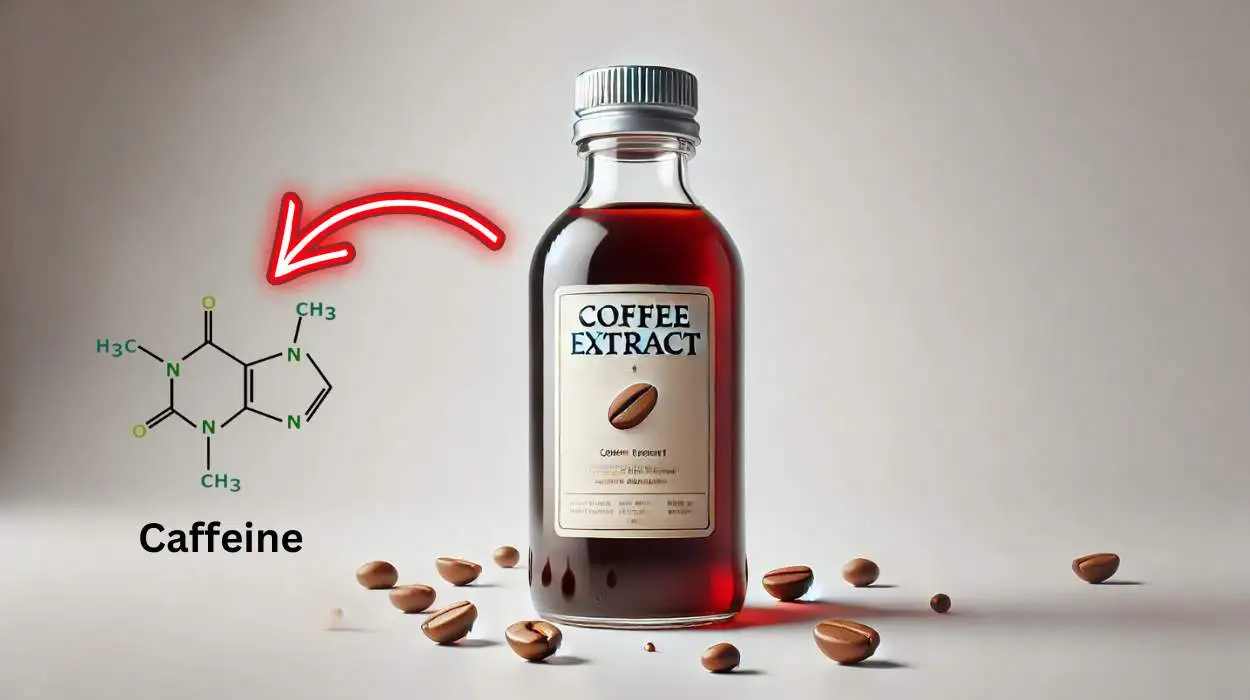When it comes to coffee, many individuals wonder if coffee extract contains caffeine. This extract, derived from green coffee beans, offers a distinct flavor profile that’s quite different from traditional brewed coffee.
The question that often arises is how coffee extract compares to regular coffees, especially when it comes to caffeine content. While caffeine is commonly found in brewed coffee, there could still be some amount of it in coffee extract. This is why it’s important to explore its composition, its benefits, and any potential risks.
I’ve often found it interesting to dive into whether coffee extract provides the same effects as regular coffee, or if it offers something unique in terms of taste and the caffeine it contains. After all, many people use it in flavoring for cakes and ice cream, highlighting the essence and source of your morning cup of joe.
Caffeine in Coffee Extract: Why It’s Important to Know
Knowing the caffeine content in coffee extract is essential, as it is a widely used ingredient in many foods, from home bakers adding it to chocolate chip cookies to major ice cream brands incorporating it into coffee-flavored creations.
It’s important to understand that coffee extract brings the deep richness of coffee without the need to brew an entire pot. Some people may assume that coffee extract is either caffeine-free or has an extremely high dose of caffeine, but the truth lies somewhere between these extremes.
The factors that impact the caffeine content include the type of coffee bean used—whether it’s Robusta or Arabica, as well as the extraction process and the concentration level.
Understanding these details is particularly relevant for people who are sensitive to caffeine, such as pregnant or breastfeeding women, and those with certain medical conditions. For these individuals, it’s best to exercise caution or even avoid coffee extract.
If in doubt, consulting a doctor about caffeine intake is the safest approach to ensure that there are no health risks or concerns.
Fun Facts About Coffee Extract!
Does Coffee Extract Have Caffeine?
Yes, coffee extract does contain caffeine. The process of creating coffee extract involves extracting the soluble compounds from coffee beans, including caffeine, using hot water or alcohol. While the amount of caffeine can vary depending on the specific product and extraction method, it’s generally present in coffee extracts.
When it comes to coffee extract, many wonder if it contains caffeine, given that it is made from coffee beans. Natural beans are rich in caffeine, which acts as a stimulant, and many individuals choose coffee extract to enjoy the advantages of caffeine without the need to consume an entire cup of brewed java.
The amount of caffeine in a serving of coffee extract can vary depending on several factors, such as the type of beans used, the extraction method, and the concentration. Some typical caffeinated products, such as brewed coffee (240ml), have about 95 mg of caffeine, while espresso shots (30ml) contain around 63 mg.
Coffee extract typically contains between 30-50 mg per teaspoon, offering a significant but manageable amount. There are also differences in natural extracts and artificial ones. Natural coffee extract, especially from green coffee beans, can have higher caffeine concentration compared to artificial versions made using synthetic chemicals designed to replicate the aroma and taste of coffee.
This is why natural coffee extract can have a range from 3% to 20% caffeine by weight. While artificial extracts might contain little to no caffeine, coffee extract is still a factor to consider for caffeine sensitivities, as the caffeine content varies based on the extraction process, the beans used, and the brewing method.
What is Coffee Extract?
Coffee extract is made by steeping ground coffee beans in hot water, then straining the liquid to remove solids. This process results in a concentrated, potent, and flavorful liquid that can be used as an ingredient in various recipes or even consumed directly for a quick caffeine boost.
The content of caffeine in coffee extract is influenced by how it is made, making it an excellent choice for people seeking a strong coffee experience without needing to brew a whole pot. It is important to note that coffee extract comes from primary varieties of Arabica beans and Robusta beans.
And the roasting process also plays a role in the flavor. However, coffee extract is often more versatile and can offer a specific caffeine level based on the extraction method, rather than being affected by the roast.
How Coffee Extract is Made
In my exploration of coffee extract, I found that it comes from coffee beans, which are available in two primary varieties: Arabica beans and Robusta beans. The flavor and caffeine content in these roasted coffee beans depends on the roasting process, with a darker roast generally leading to less caffeine.
However, when it comes to coffee extract, the extraction method plays a more significant role than the roast in determining its caffeine content. There are two main types of extraction methods—green coffee bean extract and coffee concentrate.
Green coffee extract is made from unroasted coffee beans and is known for having less caffeine than its roasted counterparts, thanks to the presence of chlorogenic acids, which are powerful antioxidants.
Coffee Concentrate and Caffeine Levels
On the other hand, coffee concentrate involves brewing coffee beans with hot water to create a strong liquid that can be diluted as needed. The amount of caffeine in coffee extract can vary depending on the extraction method, the type of bean used, the roast, and even the brand.
For example, green coffee bean extract can contain only around 20-50 milligrams of caffeine per fluid ounce, while coffee concentrate might have 100 milligrams or more.
In summary, coffee extract does contain caffeine, and its levels depend on the extraction method, the beans, and the roast, making it a versatile ingredient in products ranging from beverages to baked goods.
Homemade Coffee Extract
- Start with freshly roasted coffee beans and clean water to make your own coffee extract, which will provide an energy boost.
- Grind your chosen coffee beans to a medium-fine consistency.
- In a large jar or container with an air-tight lid, combine one part of ground coffee with four parts of hot water (not boiling).
- Stir the mixture to ensure all the grounds are fully saturated.
- Seal the container and let it steep at room temperature for 12-24 hours (the longer it steeps, the stronger and more concentrated the flavor).
- Once finished, strain out the solids using cheesecloth or a fine mesh sieve into another clean container.
- Store your homemade coffee extract in an air-tight container for up to two weeks.
Types of Coffee Extracts and Their Caffeine Content
When it comes to coffee extracts, there are different types that offer a variety of caffeine levels and uses.
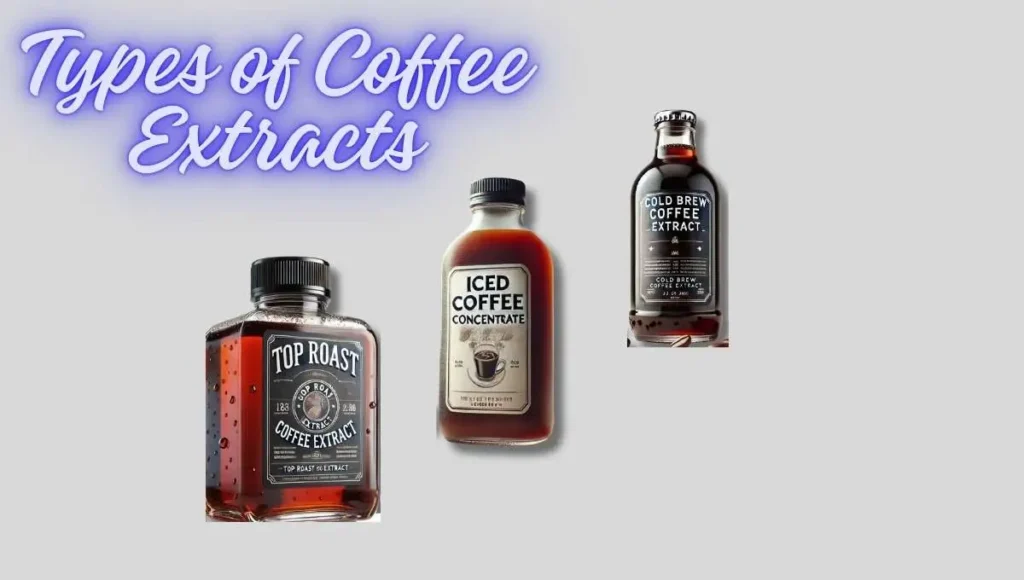
Cold Brew Coffee Concentrate
When it comes to coffee extracts, one of the most popular types is cold brew coffee concentrate. This is made by steeping roasted coffee beans in cold water for an extended period (typically 12-24 hours). The result is a smooth flavor, mild taste, and low acidity, making it perfect for iced coffee, cocktails, and other cold beverages. A typical serving of cold brew concentrate contains 200-300 mg of caffeine per 8 oz serving, offering a strong caffeine boost.
Iced Coffee Concentrate
Another type of coffee extract is iced coffee concentrate. This is made by brewing hot coffee, then cooling it down and concentrating it by removing some of the water. The caffeine content in iced coffee concentrate typically ranges from 100 mg to 170 mg per serving, depending on the specific product and brand.
Top Roast Coffee Concentrate
Top roast coffee concentrate is another variety made by brewing coffee through a high-pressure extraction method, similar to espresso. It is known for its robust flavor and thick consistency, making it ideal for hot coffee drinks such as lattes and cappuccinos. The caffeine content in top roast coffee concentrate can range from 50 mg to 150 mg per serving, depending on the specific product and brand.
Coffee Essences
Coffee essences are concentrated flavorings made by extracting the flavors from coffee beans using alcohol or other solvents. These essences are used in baking, cooking, and various culinary applications to impart a rich and complex coffee flavor. The caffeine content in coffee essences varies based on the type of beans used and the extraction process.
Green Coffee Extracts
Lastly, green coffee extracts, made from unroasted coffee beans, are widely used in supplements and other health products due to their high antioxidant content and potential health benefits. Green coffee extracts typically contain around 20-50 mg of caffeine per cup, offering a lower-caffeine alternative compared to other coffee extracts.
Natural vs Artificial Extracts
In my experience, coffee extract does contain caffeine, with natural extracts typically having a higher concentration compared to artificial ones. The amount of caffeine in coffee extract can vary depending on factors like the type of coffee beans used and the coffee-to-alcohol ratio.
For example, natural coffee extract made from green coffee beans contains around 3%-20% caffeine. On the other hand, artificial extracts may have little to no caffeine, as they are usually made from synthetic chemicals that replicate the aroma and taste of coffee.
Natural vs Synthetic Caffeine
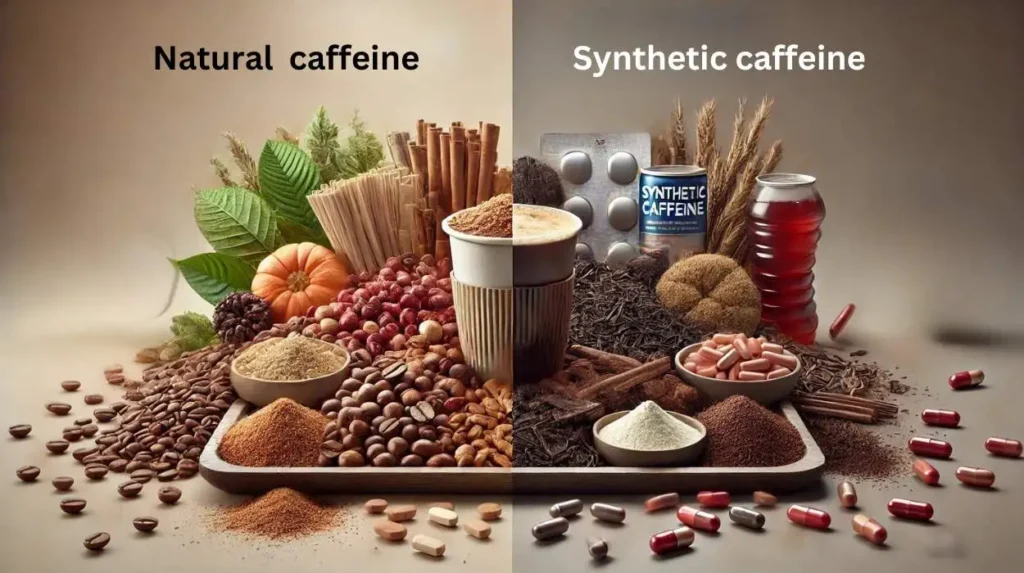
Comparing natural sources and synthetic sources is important to understand how these substances affect our bodies. Natural sources, such as coffee extracts, tea leaves, and cocoa beans, tend to provide more balanced energy levels due to their additional compounds, like antioxidants and polyphenols, which work synergistically with caffeine.
In contrast, synthetic versions, often found in energy drinks and supplements, can lead to sudden energy spikes followed by crashes, which can be harsh on the body.
Decaf Coffee Extract
While regular coffee extract can have varying caffeine content, there is also decaf coffee extract available for those who enjoy the flavor of coffee but want to avoid the stimulant effects. Decaf coffee extract is made using special processes that remove most of the caffeine from the beans before extraction.
However, it’s important to note that even decaf coffee bean extracts may still contain trace amounts of caffeine, though significantly less than their regular counterparts. This makes decaf coffee extract a great option for those who want the taste without the usual caffeine boost.
Choosing the Right Coffee Extract
- Select a high-quality coffee extract.
- Choose specialty-grade beans that are grown and processed under strict quality standards.
- Look for organic and fair trade certified products that promote sustainability and ethical practices.
- Keep in mind that the caffeine levels can differ across various extracts.
- Understand that the quantity of caffeine in a single portion can differ depending on the method of extraction and preparation.
- Make sure to check the precise caffeine content in your cup before drinking.
How Much Caffeine is in Coffee Extract?
Coffee extract is a popular choice for enjoying the taste and benefits of coffee without the need to brew an entire pot. The amount of caffeine can differ based on various components, like the kind of bean used and how long it was steeped. Typically, 30-50mg of caffeine is found per teaspoon of coffee extract.
Factors Affecting Caffeine Content
Type of Bean
When selecting a coffee extract, it’s important to understand that the type of bean plays a big role in its caffeine content. Different coffee beans, like Robusta beans, typically have higher levels of caffeine compared to Arabica beans due to their natural composition. This means that extracts made from Robusta beans will likely have more caffeine than those made with Arabica.
Steeping Time
Steeping time can significantly influence the caffeine content in the final product. The longer the ground coffee is allowed to steep in hot water, the more caffeine will be extracted. If you’re looking for a stronger cup of coffee with more kick, opting for an extract that has been steeped for a longer period might be the right choice.
Ratios & Concentration
Ratios and concentration are also key factors to consider. Some manufacturers produce highly concentrated extracts that pack more punch per serving compared to others that are diluted with ingredients like sugar or are less potent. Always check the labels carefully before purchasing any new coffee extract products to ensure you are getting the caffeine content that meets your needs.
Comparing Caffeine Levels To Other Beverages
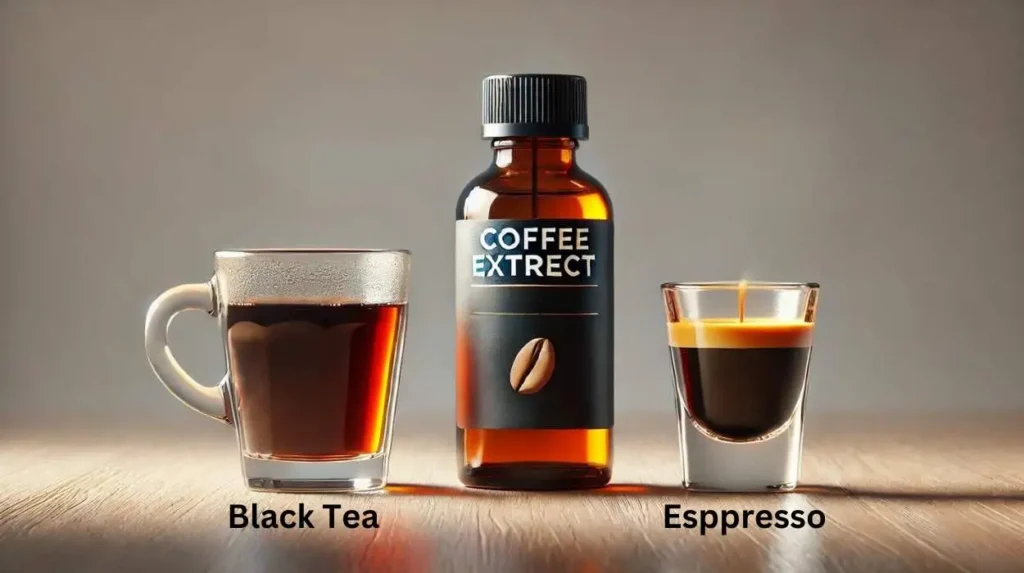
When comparing caffeine levels across different beverages, it’s interesting to note that a teaspoon of coffee extract, containing about 30-50 mg caffeine, is similar to the amount found in a 12 Oz can of cola or an 8 Oz cup of black tea.
For reference, a typical 8 Oz brewed coffee can contain anywhere from 95-200mg caffeine, while a 1 Oz espresso shot typically has 63 mg caffeine.
Even though coffee extract contains significantly less caffeine than a cup of brewed coffee, it still provides a noticeable boost. However, individual tolerances and preferences play a big role, and the effects of caffeine may vary from person to person.
Monitoring Your Caffeine Intake With Coffee Extracts
For those looking for an alternative to regular coffee, coffee extracts can offer a way to enjoy the flavor of coffee without overconsuming caffeine. The caffeine content in coffee extract can vary greatly, ranging from 0 to 120 milligrams per teaspoon.
Factors such as bean type and steeping time will influence the flavor intensity and energy boost. It’s important to keep track of how many teaspoons you consume each day, and make sure you maintain a healthy balance that works for you.
The FDA recommends that healthy adults limit daily intake to no more than 400 mg of caffeine. So, always check the serving sizes and adjust based on your personal needs.
Uses and Storage of Coffee Extract
- Coffee extract is a rich concentrate with versatility for various applications.
- Add it to baked goods like cookies or cakes for a natural flavor enhancer.
- Use it as a base for making cold brew coffee, by diluting with cold water to your desired strength.
- Create coffee-flavored cocktails or mocktails, like espresso martinis or iced lattes.
- Mix into homemade ice cream, gelato, or sorbet recipes for an extra kick of flavor and caffeine.
- Its intense flavor profile and concentrated caffeine content make it a unique alternative to traditional brewing methods.
- It provides an efficient way to get your daily caffeine fix.
- Store in a cool, dry place to preserve its strong, condensed taste for use in baking, cooking, or as a flavoring for other drinks.
Making and Storing Coffee Extract
Making coffee extract at home allows me to control the ingredients, helping me customize the flavor and manage the caffeine content.
Choose High-Quality Beans
Start by using high-quality beans, preferably freshly roasted coffee beans for the best flavor.
Grind the Coffee Beans
Coarsely grind 1 cup of coffee beans.
Mix with Cold Water
Mix the ground coffee with 2 cups of cold water in a large jar.
Stir and Refrigerate
Stir the mixture well, then cover the jar and refrigerate for 24 hours.
Strain the Mixture
After 24 hours, strain the coffee grounds using a fine-mesh strainer or cheesecloth.
Store the Extract
Store the resulting liquid in an airtight container.
Use the Coffee Extract
Use this homemade coffee extract as an alternative to brewed coffee or espresso powder in recipes, such as desserts, marinades, or as an energy booster in your morning smoothie.
Shelf Life and Storage Guidelines
Storing coffee extract correctly is crucial to preserve its freshness and avoid the growth of bacteria or mold. Since homemade coffee extract contains no added preservatives, its shelf life is shorter than store-bought varieties. To keep it fresh, store the extract in an airtight container in the refrigerator.
This helps maintain its flavor and slows microbial growth. Typically, the extract will retain its quality for about two weeks, but be on the lookout for signs of spoilage, such as an off-smell, noticeable changes in texture, or if it’s no longer suitable for consumption.
Extended Shelf Life
If you want to extend its shelf life or prevent bacteria growth from added sugar, there are two options. You can use ethanol, a food-grade ethanol, to preserve the extract for up to a year. Just add about 20% alcohol of the total volume, and it will extend the shelf life without affecting the flavor too much.
Alternatively, glycerin can act as a natural preservative and also provide a viscous texture, making it easier to measure when using the extract. Remember, it’s important to keep the extract in a cool place, monitor it for any spoilage, and practice good hygiene when handling it to ensure a safe and enjoyable culinary experience.
Health Benefits of Coffee Extract
Drinking coffee extract offers numerous health benefits, making it an attractive option for those who enjoy their daily cup of joe.
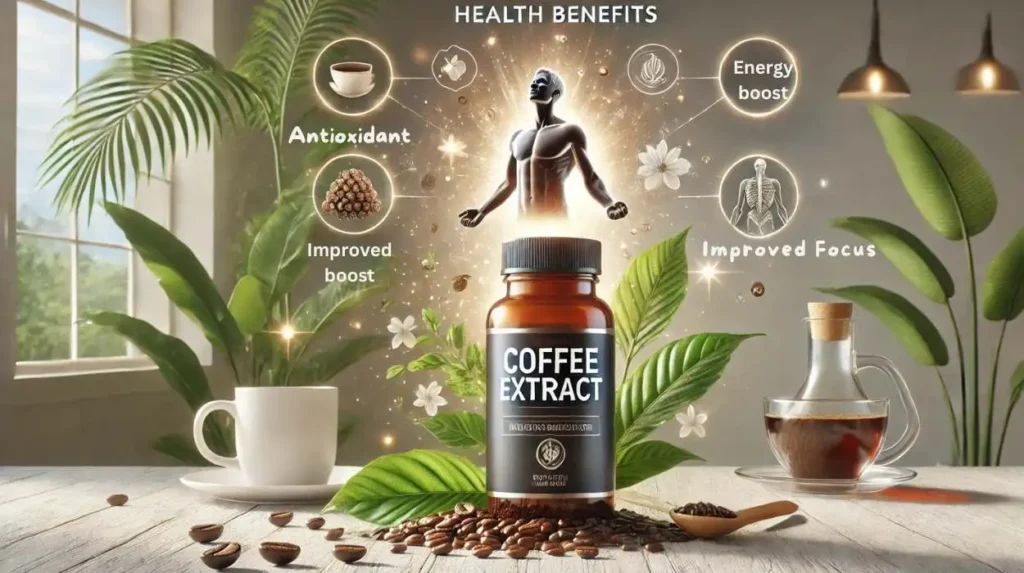
Increase in Energy Levels
Drinking coffee extract offers numerous health benefits, making it an attractive option for those who enjoy their daily cup of joe. One major benefit is the invigoration it provides, helping to boost energy levels, improve focus, and increase concentration.
The caffeine in coffee extract stimulates the central nervous system, which can enhance physical performance by boosting adrenaline levels.
Improved Focus and Concentration
Studies have shown that moderate caffeine intake can sharpen reaction time, improve memory recall, and enhance mental performance, especially during demanding tasks.
Disease Prevention
Coffee extract may also contribute to disease prevention. Research indicates that regular coffee consumption can help reduce the risk of type 2 diabetes due to its antioxidant properties, which help regulate blood sugar levels.
A meta-analysis of various studies has shown a significant inverse relationship between coffee intake and type 2 diabetes risk. Parkinson’s Disease prevention has also been linked to higher caffeine intake, with studies, including one in JAMA Neurology, suggesting that neuroprotective benefits from caffeine can reduce the risk of this degenerative condition.
Additionally, moderate coffee consumption has been shown to lower the risk of heart disease by improving blood vessel function and reducing inflammation.
Antioxidant Protection
A component found in coffee, chlorogenic acid, is known for its anti-inflammatory properties and has also been linked to improved blood pressure and a reduced risk of developing type 2 diabetes. Antioxidants in coffee, including chlorogenic acid, help protect the body from free radicals, further contributing to overall health.
Safety and Side Effects
Safety
When consuming coffee extract, moderation is key to enjoying its benefits without experiencing any adverse effects. To safely consume coffee extract, it’s important to follow a few simple tips. The daily limit for most adults is about three teaspoons of coffee extract, roughly 90-150mg of caffeine, depending on individual tolerance levels.
Side Effects
Excessive caffeine intake can lead to side effects such as headaches, insomnia, and anxiety. For example, overconsumption of caffeine may trigger migraines or tension-type headaches in some individuals, while high levels can also disrupt sleep patterns, making it harder to fall asleep at night.
Additionally, caffeine stimulates the central nervous system, which could lead to jitteriness or increase feelings of anxiety in sensitive individuals. You should also avoid late-night consumption to prevent insomnia.
Try not to drink coffee extract at least six hours before bedtime if you find that it affects your sleep. Monitor your body’s response to coffee extract and adjust your intake or frequency if you experience any unwanted effects.
Nutritional Information and Ingredients
Coffee extract is made from a few simple ingredients like coffee beans, water, and sometimes alcohol or sugar, depending on the type. It is low in calories but rich in antioxidants, which are beneficial for the body.
The caffeine content in coffee extract can vary depending on the preparation, making it a flexible option for those looking to control their intake of caffeine. While the amount of caffeine differs based on the method, coffee extract still provides the benefits of antioxidants along with the energizing effects of caffeine. This makes it a flavorful yet healthier choice compared to other caffeinated drinks.
List Of Ingredients In Coffee Extract
Coffee Beans
Coffee extract is typically made from a variety of coffee beans like Arabica or Robusta, each with its own roast level.
Roast Level
Light roasts give the extract brighter, more acidic notes, while dark roasts add deeper, richer, and sometimes smoky flavors to the flavor profile.
Alcohol or Glycerin
The process often includes alcohol or glycerin, which act as solvents to pull the delicious flavors and caffeine from the beans.
Vodka
Vodka is the most common solvent due to its neutral flavor, allowing the pure coffee essence to shine through.
Other Spirits
Other spirits like rum, bourbon, or brandy can also be used, adding their own unique flavor characteristics, complexity, and depth.
Food-Grade Glycerin
For those looking for non-alcoholic alternatives, food-grade glycerin is often used, which creates a slightly sweeter and less intense extract than alcohol-based versions.
Propylene Glycol
Other solvents like propylene glycol are used in extracts meant for cosmetic use, helping to maintain consistency and assist in distribution in products like skincare.
Water
Some manufacturers dilute the highly concentrated extract with water, making it easier to use in recipes and creating a milder flavor profile.
Preservatives
In commercial products, preservatives like potassium sorbate and sodium benzoate are sometimes added to prevent spoilage and extend the shelf life of the extract.
Coffee Extract Nutritional Information
A 6 fl Oz serving of Dunkin’ Cold Brew Coffee Concentrate contains just 15 calories. It has 0g of fat content and a very small amount of sodium at 5mg. Each serving provides 3g of carbohydrates, along with 1g of protein.
You’ll also get a boost of potassium with 309mg (which is 6% of the daily value) and a bit of iron, around 1mg, or 2% of the daily value. This makes it a fairly light yet energizing option, with a good amount of essential minerals in each serving.
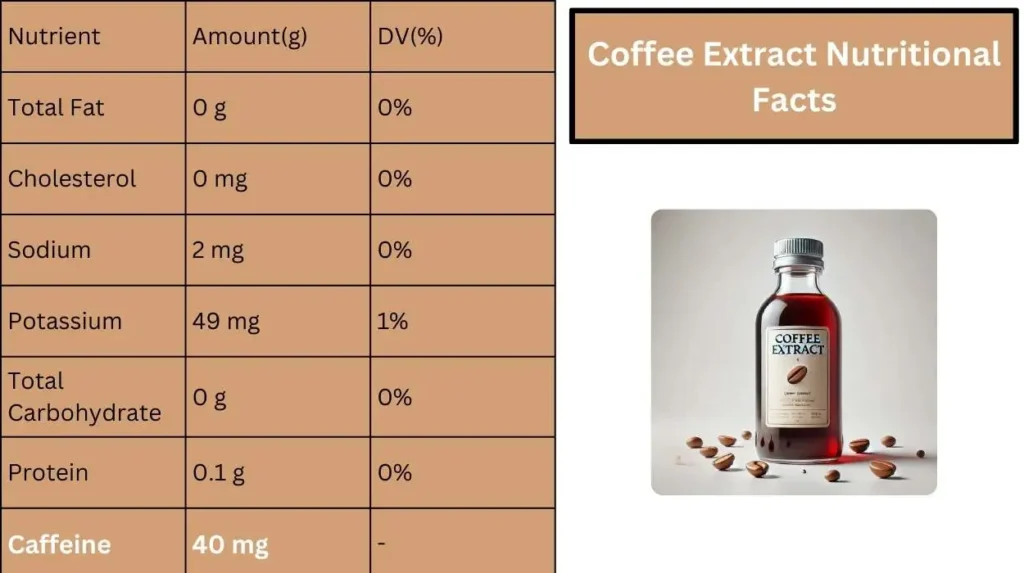
Alternatives to Coffee Extract
If you’re looking for a flavorful alternative to coffee extract, there are plenty of options available, each with its own unique flavor profile and caffeine content.
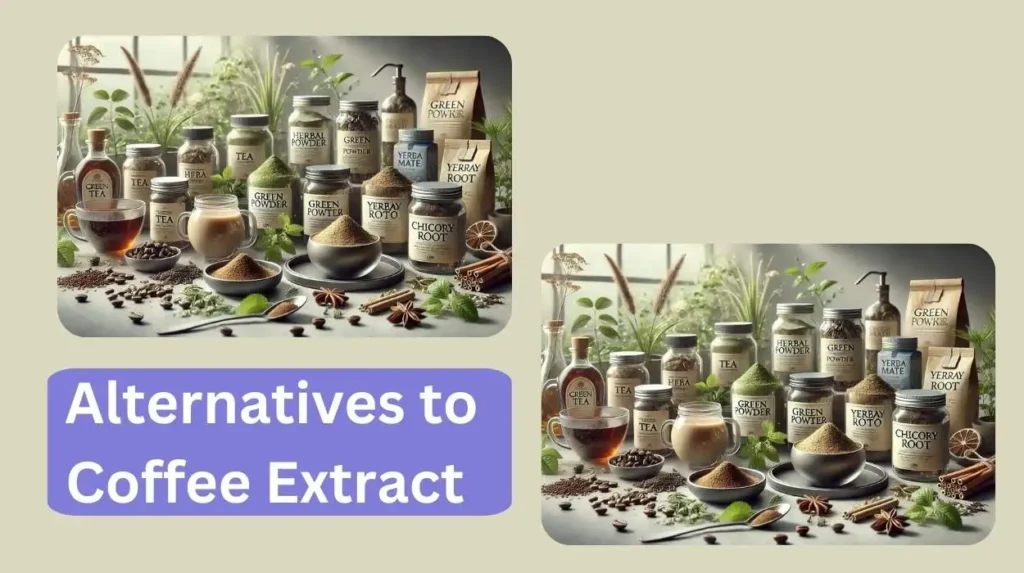
Matcha Tea
If you’re looking for a flavorful alternative to coffee extract, matcha tea, a finely powdered Japanese green tea, offers a vibrant green color and a slightly grassy, vegetal flavor.
It provides 30-70mg of caffeine per teaspoon, as well as L-theanine, an amino acid that helps with focus and relaxation without the typical jitters associated with coffee. This makes matcha an excellent option for a sustained, calm energy boost.
Black Tea
Black tea is another versatile alternative. Known for its robust flavor, black tea can have 47 mg of caffeine per cup, offering a moderate caffeine kick.
Whether you enjoy the brisk, malty notes of Assam or the more floral, delicate flavors of Darjeeling, black tea provides a satisfying caffeine boost with a wide variety of flavors depending on the type and origin of the tea leaves.
Green Tea
If you’re seeking something with a lighter touch, green tea may be the right choice. It has a grassy flavor profile and contains 28 mg of caffeine per cup, which is less than black tea but still provides a gentle energy lift. It’s rich in antioxidants, making it a great option for potential health benefits like protecting the body from free radicals.
Yerba Mate
For those who want a truly unique experience, Yerba mate, a South American beverage, offers a slightly bitter, earthy flavor with 80mg of caffeine per cup. It’s packed with vitamins, minerals, and antioxidants, providing a stimulating lift along with extra nutritional benefits.
Guayusa
Similarly, Guayusa, a caffeinated holly from the Amazon, is brewed into a tea with a smooth, subtly sweet flavor and provides clarity and focus without the usual jitteriness.
Chicory Root
If you’re seeking caffeine-free alternatives, chicory root is a great option. Its nutty, earthy, woody notes resemble coffee, but it’s naturally caffeine-free and a rich source of inulin, a prebiotic fiber that supports gut health.
Dandy Blend
Dandy Blend, a popular coffee substitute, combines roasted barley, rye, chicory root, and dandelion root to create a rich, dark flavor without any caffeine.
Rooibos Tea
For a naturally caffeine-free tea, rooibos tea, a South African herbal tea, has a sweet, fruity flavor and is loaded with antioxidants, making it a healthy choice.
Cacao
Cacao, which has a mild stimulant effect from theobromine, offering a rich, chocolatey flavor in desserts or hot cocoa, provides a small hint of stimulation and comforting flavor.
Herbal Teas
A wide range of herbal teas like peppermint, chamomile, and ginger, all caffeine-free, with potential health benefits such as digestion support and stress reduction make for a great choice. These alternatives provide a diverse array of flavors and energy levels to suit various preferences and needs.
| Drink | Stimulant Level |
| Rooibos Tea | Caffeine-free |
| Black Tea | 47mg/cup |
| Chicory Root | Caffeine-free |
| Guayusa | 28mg/cup |
| Matcha Tea | 30-70 mg/tsp |
| Cacao | Small amount of theobromine |
| Yerba Mate | 80mg/cup |
| Green Tea | 28mg/cup |
| Dandy Blend | Caffeine-free |
| Herbal Teas | Caffeine-free |
Recommended Daily Intake
When consuming coffee extracts, it’s important to be mindful of how much you consume since they pack a caffeine punch. The Recommended Daily Intake (RDI) of caffeine for healthy adults is about 400 mg. Different coffee extracts have varying levels of caffeine.
For example, cold brew coffee concentrate is particularly potent, with 200-300mg of caffeine per single 8 oz serving, reaching up to 75% of the RDI. Iced coffee concentrate contains 100-170 mg per serving, providing 25-42.5% of the RDI.
Top roast coffee concentrate ranges from 50-150 mg per serving, making up 12.5%-37.5% of the RDI, while green coffee has a more moderate amount of 20-50mg per cup, about 5%-12.5% of the RDI.
Since caffeine can add up quickly, it’s crucial to always check product labels and monitor portion sizes when tracking caffeine consumption. Everyone’s individual sensitivities to caffeine vary, so it’s especially important for pregnant or breastfeeding individuals to discuss caffeine intake with their doctors.
Conclusion
When using coffee extract in recipes, it’s important to consider the caffeine content, as it can vary depending on the type of extract, the beans used, and the extraction process. The concentration of caffeine may differ, so it’s essential to be mindful of your individual caffeine tolerance and serving size.
Always check the label of your chosen extract to stay within your desired intake levels. If you’re craving the coffee flavor without the caffeine, exploring caffeine-free alternatives can be a great option to enjoy the taste without any of the stimulating effects.
FAQs
Does coffee extract in ice cream have caffeine?
Yes, caffeine is present in ice cream containing coffee extract.
Does coffee extract give you energy?
Yes, coffee extract can give you energy due to its caffeine content. It also contains antioxidants and provides an energy boost.
Is coffee fruit extract high in caffeine?
Coffee fruit contains caffeine, with the amount varying depending on the specific product, dosage, and form. Most products typically contain around 5-20 mg of caffeine per serving, which can contribute to an energy boost.
What’s the difference between coffee and coffee extract?
Coffee is brewed from ground coffee beans, while coffee extract is a concentrated form made by steeping coffee beans in water or alcohol to extract the flavor and caffeine. Coffee extract is more potent and can be used in recipes or drinks.

